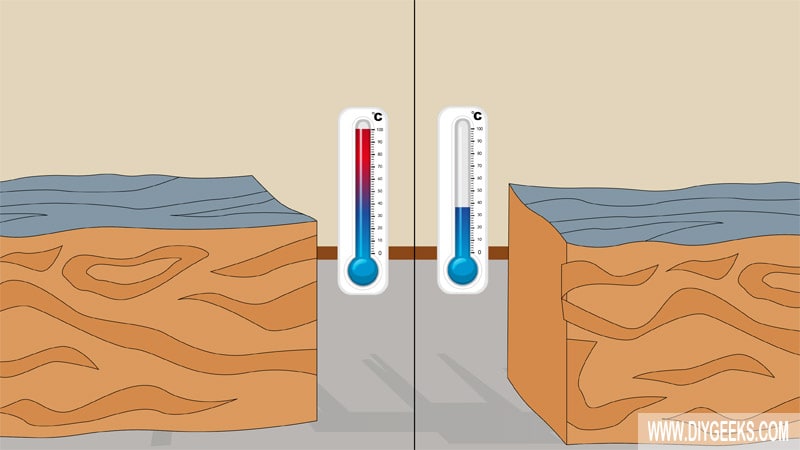Temperature does affect paint drying time as it determines the paint solvent evaporation rate. The higher the temperature, the faster the paint coating dries because its solvent (oil or water) evaporates faster.
Paint coatings dry through solvent evaporation — the paint solvent (oil or water) evaporates from the coating and the coating becomes hard (rigid). The faster the solvent evaporates, the faster the paint dries.
The ideal temperature for panting is between 50°F-85°F (10°C-30°F). The ideal humidity level for painting is lower than 50%.
Does Paint Dry Faster at Higher Temperatures?
Paint does dry faster at higher temperatures (50°F/10°C and above) as its solvent (water or oil) evaporates faster. The faster the solvent evaporates, the faster the paint dries.
Paint doesn’t dry faster at lower temperatures and moist conditions as the solvent evaporates slower.
How Does Paint Dry?
Paint dries through solvent evaporation — the paint solvent (water or oil) must evaporate from the surface and the coating must become hard (rigid). Most paint formulated include solvent (water or oil), binders, pigments, and other additives.
The paint binder, pigments, and additives are dissolved with a solvent to keep them from solidifying in the container. Once you apply the paint, the paint solvent slowly starts to evaporate and the other additives start to solidify and become hard. Once the solvent evaporates, the additives become hard and form a durable and colorful paint film (finish).
Since oil-based paint is formulated with oil as its solvent and has extra additives, it takes longer to dry than water-based paint.
What Affects the Paint Dry Time?
Besides temperature, other factors that affect paint dry time are listed below.
- Humidity Levels.
- Paint Number of Coats.
- Surface Prep.
Humidity Levels
Humidity refers to the water vapor or moisture in the air and it’s expressed with a percentage. The higher the humidity levels, the higher the atmospheric moisture content.
Paint dries slower if the humidity levels are high because the paint solvent evaporates at a lower rate if there’s more water vapor or moisture in the air.
For paint to dry at a normal rate, the humidity levels must be lower than 50%. If the humidity levels are higher than 50%, the paint finish takes longer to dry, turns sticky or tacky, and can peel off.
Paint Number of Coats
The paint number of coats and coat viscosity can determine the paint drying time. The more thick paint coats you apply, the longer the coats take to dry as there’s more solvent on the surface that must evaporate.
Thin paint coats dry faster as there’s less solvent to evaporate and fewer additives to solidify or become hard (rigid).
Surface Prep
Surface preparation can affect the paint drying time. If the surface is dirty or wet, the paint takes longer to dry or won’t dry at all. You must clean and dry the surface before painting it.
A dirty surface prevents paint from properly penetrating and adhering to it. A wet surface increases the paint dry time as the surface moisture (or water) prevents the additives to solidify or become hard.
Does Temperature Affect Paint Curing Time?
Temperature does affect the paint curing time, but it’s not the only factor. Warmer temperatures and lower humidity levels lead to a faster curing time.
The paint curing time refers to the time period it takes paint to reach its maximum durability, strength, and adhesion.
When the paint solvent evaporates, the paint coating goes under a process called “film formation” where the binders and additives begin to solidify and become hard. Once the binders are additives solidify, the paint curing process starts.
Oil-based paint cures through oxidization, where the paint oils react with the oxygen. So, the airflow can also determine the paint curing time.
What’s The Ideal Temperature For Painting?
The ideal temperature for painting is between 50°F-85°F (10°C-30°F). Within this temperature range paints dry and cure efficiently and on time.
The ideal humidity levels for painting are below 50%. The lower the humidity levels the faster the paint dries.
Paint dries faster outdoors than indoors during high-temperature days. Paint dries slower outdoors than indoors during low-temperature days as the humidity levels are higher.
The indoor temperature doesn’t need to be too high for paint to dry as the warmth indoors is trapped and will circulate inside longer than outdoors.
What Happens If You Paint When the Temperature Is Too Low?
If you paint when the temperature is too low, paint remains wet longer, turns sticky or tacky, and can peel off.
During low temperatures, the solvent takes longer to evaporate and keeps the coating wet. The longer the paint coating is wet, the more it accumulates dust and dirt, especially outdoors. If a wet paint coating accumulates too much dirt, it gets contaminated and will peel off.
If the temperature is too low, use a hairdryer or heater to accelerate the solvent evaporation rate and make the paint dry faster.
What Happens If You Paint When The Temperature Is Too High?
If you paint when the temperature is too high, the paint dries too fast and can crack or peel off. High temperatures make the paint solvent (oil or water) evaporate too fast from the coating.
If the solvent evaporates too fast, the paint binders and additives don’t have enough time to bond naturally, forming a weak bond. Since the bond between paint additives is weak, the paint finish gets cracked and can get damaged with little effort.
For paint to be strong and durable, the additives have to bond and solidify naturally. When the additives bond together, the coating will become strong and can handle traffic and furniture weight.


